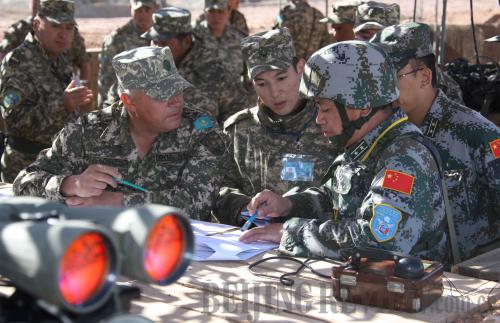|
 |
|
JOINT MISSION: Chinese and Kazak officers discuss training plans during the "Peace Mission 2010" joint antiterror drill on Matybulak Range in Kazakhstan on September 14 (WANG JIANMIN) |
Shanghai Cooperation Organization (SCO) members have been holding joint military exercises since 2003. And this year's was called "Peace Mission 2010."
Analysts say the exercises, aimed at striking the "three evil forces" of extremism, separatism and terrorism in Central Asia, now play an important role in maintaining regional peace and stability, and will benefit the whole region and beyond.
Highlights
This year's drill was the seventh antiterrorism military exercise under the SCO framework. In total, about 5,000 troops—China, Russia, Kazakhstan, Kyrgyzstan and Tajikistan each dispatched around 1,000—participated in the drill in Kazakhstan from September 10 to 25. The exercise was divided into three phases: strategic consultation, joint antiterror battle preparation and joint antiterror battle implementation.
"This year's drill differed from the previous six in scale, distance and duration," Feng Changhong, a senior research fellow with the Academy of Military Sciences of the People's Liberation Army (PLA), said to Beijing Review. He pointed out that the drill had drawn the most troops of SCO antiterror exercises, even without Uzbekistan's participation.
Chen Jianmin, also a research fellow with the PLA's Academy of Military Sciences, said as mutual trust and cooperation in political, economic and military aspects strengthen under the SCO framework, the organization's joint antiterror military exercise system is maturing. SCO members now have strong desires to attend joint drills, he told China News Service.
The PLA dispatched 1,000 troops to this year's exercise, including a ground force combat group, an air force combat group and a logistics group. The troops traveled more than 5,000 km to get to the drill site in Kazakhstan; this was a big test for the PLA's comprehensive transportation capability. The exercise lasted 15 days—the longest one ever, Feng said, adding that this was also the first time that China dispatched three different groups.
The real highlight was the participation of sophisticated weapons, like China's J-10 fighter and H-6 bomber, Feng noted. Although these are conventional PLA weapons, "Peace Mission 2010" was the first overseas drill for them.
In regular drills, the H-6 bomber has hit its target 100 percent of the time, which is an impressive feat, he said. Also, China's helicopters have demonstrated the ability to operate at extremely low levels—only 40 meters off the ground in a valley—which is a big challenge to pilots' skill.
Chen also pointed out that some new types of antiterror equipment appeared during the drill. In recent years, Russia has upgraded its weaponry with smaller, mechanized types, and these weapons were tested in the practical battle environment.
Li Shuyin, who is also from the PLA's Academy of Military Sciences, said that this year's drill reflected high mutual trust among SCO members, because Kazakhstan, the host nation, allowed foreign air forces to fly from their home countries to Kazakhstan to participate in the drill without stopping.
The SCO stands for mutual respect and seeks common ground while shelving differences, which can be read from this year's drill too, said Li. Although SCO members have different economic, social and natural conditions, they dispatched equal numbers of troops to the drill and participated equally in the strategic consultations. The equality of its members would add to the solidarity of this organization, Li said.
| 